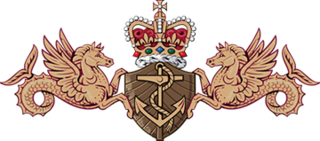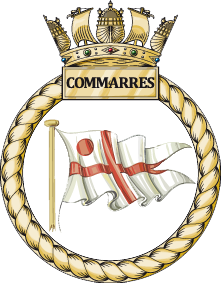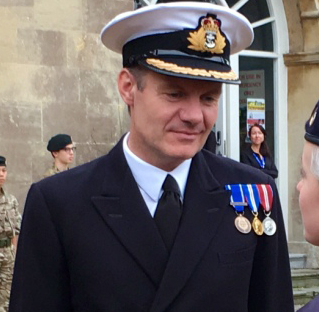
The Second Sea Lord and Deputy Chief of Naval Staff is deputy to the First Sea Lord and the second highest-ranking officer to currently serve in the Royal Navy and is responsible for personnel and naval shore establishments. Originally titled Second Naval Lord in 1830, the post was restyled Second Sea Lord in 1904. They are based at Navy Command, Headquarters.

The Admiralty Board is the body established under the Defence Council of the United Kingdom for the administration of the Naval Service of the United Kingdom. It meets formally only once a year, and the day-to-day running of the Royal Navy is conducted by the Navy Board, which does not include any ministers.

The Commander-in-Chief Fleet (CINCFLEET) was the admiral responsible for the operations of the ships, submarines and aircraft of the British Royal Navy from 1971 until April 2012. The post was subordinate to the First Sea Lord, the professional head of the Naval Service. In its last years, as the Navy shrank, more administrative responsibilities were added.

The Royal Navy Surface Fleet forms one of the five fighting arms of the Royal Navy.
Vice Admiral Matthew John Tripovich, is a retired senior officer of the Royal Australian Navy. He served as Chief Capability Development Group from 2007 until his retirement in October 2010.
Fleet Command is responsible for the command, operations, readiness, training and force generation of all ships, submarines, aircraft squadrons, diving teams, and shore establishments of the Royal Australian Navy. Fleet Command is headquartered at HMAS Kuttabul in Sydney, and is led by the Commander Australian Fleet (COMAUSFLT), also referred to as Fleet Commander Australia (FCAUST), which is a rear admiral (two-star) appointment.

Admiral Sir Philip Andrew Jones, is a retired senior Royal Navy officer. After service in the South Atlantic in 1982 during the Falklands War, he commanded the frigates HMS Beaver and HMS Coventry. He went on to be Flag Officer, Scotland, Northern England and Northern Ireland, Commander United Kingdom Maritime Forces and Assistant Chief of the Naval Staff before being appointed Fleet Commander and Deputy Chief of the Naval Staff. Jones served as First Sea Lord from April 2016 to June 2019.

The Fleet Commander is a senior Royal Navy post, responsible for the operation, resourcing and training of the ships, submarines and aircraft, and personnel, of the Naval Service. The Vice-Admiral incumbent is required to provide ships, submarines and aircraft ready for operations, and is based at Navy Command Headquarters.

The Assistant Chief of the Naval Staff (A.C.N.S.) is a senior appointment in the Royal Navy usually a two-star rank and has a NATO ranking code of OF-7.

The Commander Operations (COMOPS) is a senior Royal Navy officer based at Northwood Headquarters who exercises operational command of all national maritime operations on behalf of the Fleet Commander. The post was established in 1993.

The Maritime Reserve is a term used to group together the Royal Naval Reserve (RNR) and Royal Marines Reserve (RMR). The RNR and RMR form part of the British Armed Forces Volunteer Reserves.

The Deputy Chief of the Naval Staff (DCNS) is a senior appointment in the Royal Navy currently held by the Second Sea Lord. The incumbent is usually a three-star rank and had a NATO ranking code of OF-8, but the position has previously been held by an acting two-star ranked officer and a four-star ranked officer.

Admiral Sir Keith Edward Blount, is a senior Royal Navy officer and pilot, who since July 2023 serves as NATO's Deputy Supreme Allied Commander Europe. He was Assistant Chief of Naval Staff and head of the Fleet Air Arm from 2015 to 2019. He served as Commander Allied Maritime Command, NATO, from 2019 to 2023.

The Assistant Chief of the Naval Staff (Capability) is a senior Royal Navy appointment responsible he is accountable for planning and delivering the larger part of future maritime effectiveness; he does this on behalf of the First Sea Lord.

The Assistant Chief of the Naval Staff (Personnel) is a senior Royal Navy appointment responsible for the sustainable delivery of sufficient, capable and motivated personnel to the Naval Service in support of Defence Outcomes; he does this on behalf of the First Sea Lord and Chief of the Naval Staff. It has now subsumed under Director People and Training.

The Chief of Staff Navy Command (HQ) is a senior Royal Navy appointment is the principal staff officer responsible for coordinating the supporting staff of Navy Command Headquarters, Portsmouth, England. The office was established in June 2010.

The Naval Staff Directorate is a military staff directorate created in 1985 as the Directorate of Naval Staff Duties. The directorate was originally part of the British Ministry of Defence and is now under the Ministry of Defence as part of Navy Command. It is currently administered by the Commodore Naval Staff now based at MOD HQ.

Vice Admiral Martin John Connell, is a senior Royal Navy officer currently serving as Second Sea Lord.

Commodore Nicholas Henry Charles Tindal is a senior Royal Navy officer who served as the commanding officer of RNAS Yeovilton until July 2020.












